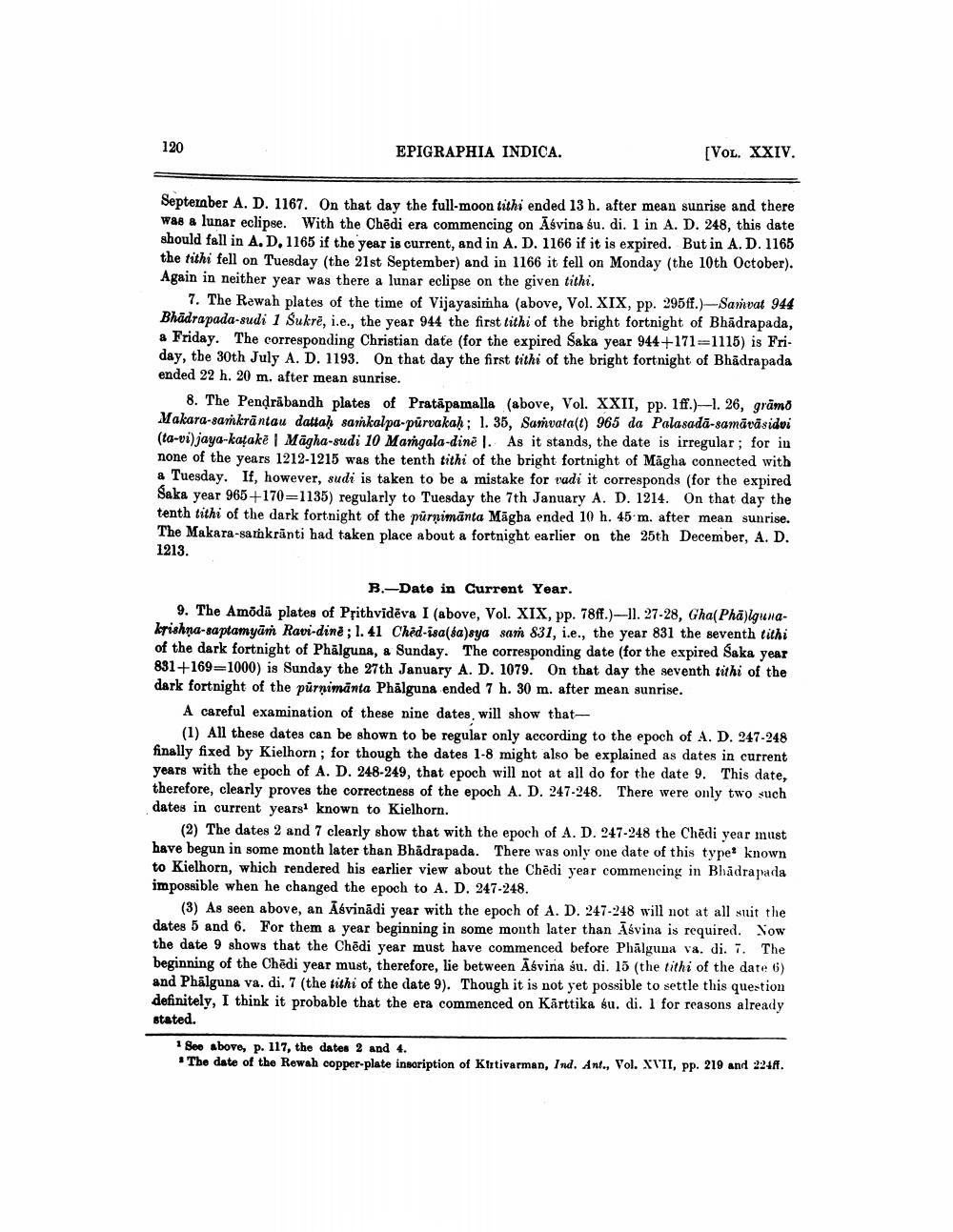________________
120
EPIGRAPHIA INDICA.
[VOL. XXIV.
Septeraber A. D. 1167. On that day the full-moon tithi ended 13 h. after mean sunrise and there was a lunar eclipse. With the Chēdi era commencing on Asvina su. di. 1 in A. D. 248, this date should fall in A.D. 1165 if the year is current, and in A. D. 1166 if it is expired. But in A.D. 1165 the tithi fell on Tuesday (the 21st September) and in 1166 it fell on Monday (the 10th October). Again in neither year was there a lunar eclipse on the given tithi.
7. The Rewah plates of the time of Vijayasimha (above, Vol. XIX, pp. 295ff.)-Samvat 944 Bhadrapada-sudi 1 Sukrē, i.e., the year 944 the first tithi of the bright fortnight of Bhädrapada, a Friday. The corresponding Christian date (for the expired Saka year 944+171=1115) is Friday, the 30th July A. D. 1193. On that day the first tithi of the bright fortnight of Bhadrapada ended 22 h. 20 m. after mean sunrise.
8. The Pendrăbandh plates of Pratapamalla (above, Vol. XXII, pp. 1ff.)-1. 26, grāmo Makara-samkrāntau dattah sankalpa purvakah : 1. 35, Sanvata(t) 965 da Palasadā-samāvāsidui (ta-vi)jaya-kațake | Magha-sudi 10 Margala-dine l. As it stands, the date is irregular; for in none of the years 1212-1215 was the tenth tithi of the bright fortnight of Mägha connected with & Tuesday. If, however, sudi is taken to be a mistake for vadi it corresponds (for the expired Saka year 965 +170=1135) regularly to Tuesday the 7th January A. D. 1214. On that day the tenth tithi of the dark fortnight of the purnimänta Mágba ended 10 h. 45 m. after mean sunrise. The Makara-sankranti had taken place about a fortnight earlier on the 25th December, A. D. 1213.
B.-Dato in Current Year. 9. The Amõdā plates of Prithvidēva I (above, Vol. XIX, pp. 78ff.)--)). 27-28, Gha( Phālgunakrishna-saptamyāṁ Ravi-dine; 1. 41 Ched-isa(sa)sya sa 831, i.e., the year 831 the seventh tithi of the dark fortnight of Phälguna, & Sunday. The corresponding date (for the expired Saka year 831+169=1000) is Sunday the 27th January A. D. 1079. On that day the seventh tithi of the dark fortnight of the pūrnimanta Phālguna ended 7 h. 30 m. after mean sunrise.
A careful examination of these nine dates will show that
(1) All these dates can be shown to be regular only according to the epoch of A. D. 247-248 finally fixed by Kielhorn; for though the dates 1-8 might also be explained as dates in current years with the epoch of A. D. 248-249, that epoch will not at all do for the date 9. This date, therefore, clearly proves the correctness of the epoch A. D. 247-248. There were only two such dates in current yearst known to Kielhorn.
(2) The dates 2 and 7 clearly show that with the epoch of A. D. 247-248 the Chēdi year must have begun in some month later than Bhadrapada. There was only one date of this type known to Kielhorn, which rendered his earlier view about the Chēdi year commencing in Bhadrapada impossible when he changed the epoch to A. D. 247-248.
(3) As seen above, an Asvinādi year with the epoch of A. D. 247-248 will not at all suit the dates 5 and 6. For them a year beginning in some month later than Āsvina is required. Now the date 9 shows that the Chēdi year must have commenced before Phälguna va. di. 7. The beginning of the Chēdi year must, therefore, lie between Asvina su. di. 15 (the tithi of the date 6) and Phālguna va. di. 7 (the tithi of the date 9). Though it is not yet possible to settle this question definitely, I think it probable that the era commenced on Kārttika su. di. 1 for reasons already stated.
1 See above, p. 117, the dates 2 and 4. • The date of the Rewah copper-plate insoription of Kirtivarman, Ind. Ant., Vol. XVII, pp. 219 and 22418.




